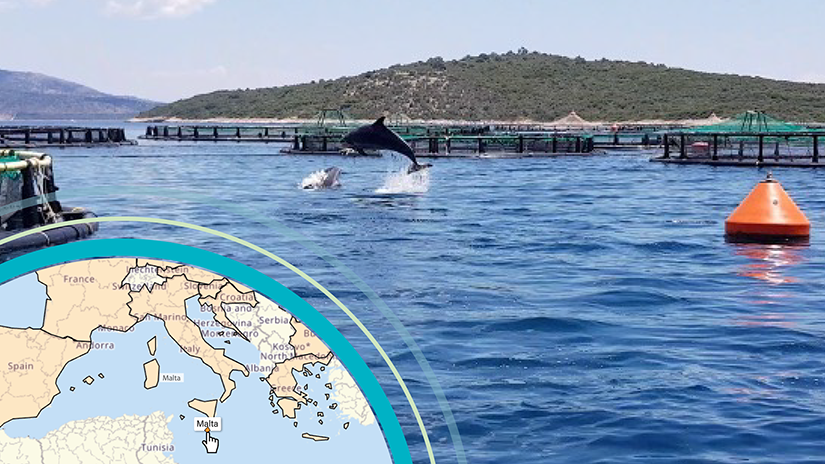Background information

Type of species farmed
Atlantic bluefin tuna (Thunnus thynnus), gilthead seabream (Sparus aurata). Alternative fish species have been cultured by the Aquaculture Directorate, such as the meagre (Argyrosomus regius), seabream (Diplodus sargus), European seabass (Dicentrarchus labrax) and the greater amberjack (Seriola dumerili).
Sources: 2024, EUMOFA; MNSPA
Type of production method
In Malta, aquaculture occurs in sea and brackish water. The following main production methods were used in 2022:
The Maltese aquaculture industry is entirely dependent on marine resources and is divided into two distinct sectors being:
- the Capture-Based Aquaculture (CBA) of Atlantic bluefin tuna (Thunnus thynnus).
- the Closed-Cycle Species (CCS), mainly gilthead seabream (Sparus aurata) and European seabass (Dicentrarchus labrax).
Commercial production of these CBA and CCS systems is exclusively conducted in floating cage culture systems.
Sector’s size (production and consumption)
Given the significant relevance of imports of frozen fish likely used directly as fish feed in the Maltese Bluefin tuna fattening industry, available data and information for Malta do not allow to produce precise estimates.
Source: 2024, EUMOFA
Trends (past and future)
- A more competitive and resilient aquaculture sector that develops in balance with good environmental practices and societal expectations.
- The provision of streamlined and less bureaucratic governance processes, promoting transparent and accountable practices for the public and the commercial enterprises in the industry.
- The Aquaculture Directorate is investing in sustainable strategies for production. Specifically, these include Integrated Multi-Trophic Aquaculture (IMTA) primarily for fish-invertebrate systems, and aquaponics using gilthead Sea bream and lower trophic organisms including polychaetes, halophytes and macroalgae integrated in a recirculated aquaculture system.
Source: MNSPA
Impact of aquaculture in the country’s economy, food market and labour market
- The aquaculture industry in Malta has considerable socio-economic value and potential as it enhances the overall economic diversification, contributes to employment generation, provides valuable export earnings, and contributes towards the EU trade deficit for fisheries products.
- In 2020, the value added of the Maltese aquaculture industry was € 217.5 million of which, 91% coming from tuna farming, 8% from CCS and 1% is coming from other output/revenue.
- The tuna industry became one of the island’s major exporters of fish products, namely to Japan as a frozen product for the sushi and sashimi trade.
- CCS production, instead, has seen a considerable decrease in the past years. These changes are due to market fluctuations and different production strategies from the operators. Almost all the CCS production is exported as whole, gutted/ungutted fresh fish to Europe and North Africa.
- Maltese aquaculture is a valid economic sector with a positive growth potential and its expected expansion is based on the potential identification of new aquaculture zones to be used for CCS and other novel species and on reaching the CCS production target of 5,000 tonnes, in addition to the tuna farming production, until 2030. It is forecasted that the industry will increase direct and indirect jobs by up to 25% by 2030 with a Gross Value Added of around €70 million to the Maltese economy.
Source: MNSPA
Challenges and opportunities
- CCS sector still struggles to overcome limitations related to space, resources and market related factors.
- Continuing to play a major role in the world’s Bluefin tuna industry.
- Global demand for high-quality seafood.
- Reinforcing the leadership in offshore aquaculture.
- Promoting aquaculture diversification.
- Introducing new aquaculture concepts.
- Introducing quality control schemes.
- Set up a new Aquaculture Research Centre.
- Develop lower trophic level species culture.
- Use of financial instruments.
- Vast Maltese waters open the door for further development of offshore aquaculture.
- The sector also has an opportunity to lead the way as an innovator in the culture of alternative species, culture technologies and sustainable feed development.
Source: MNSPA
Employment and number of enterprises
7 fish farming operators
Source: MNSPA
Multi-annual National Strategic Plans for the development of sustainable Aquaculture
Relevant Authorities
- Ministry for Agriculture, Fisheries and Animal Rights (MAFA)
- Aquaculture Directorate
- Environment and Resource Authority (ERA)
- Planning Authority (PA)
- Animal Health and Welfare Department (AHWD)
- Lands Authority (LA)
- Transport Malta (TM)
- Malta Competition and Consumer Affairs Authority (MCCAA)
- Ministry for Education, Sport, Youth, Research and Innovation (MEYR)
Applicable Legislation
- CAP 425 – Fisheries Conservation and Management Act
- S.L. 425.02 – Fish Market Regulations
- S.L. 425.03 – Tunny Fish (Importation) Restriction Order
- S.L. 425.05 – Fisheries and Aquaculture Services Payments Regulation
- S.L. 425.12 – Aquaculture Operations Regulations
- L.N. 157/2017- Aquaculture Operations Regulations, 2017
- S.L. 425.13 – Blue Fin Tuna Harvesting Regulations
- Environment Protection Act (CAP. 549)
- Marine Policy Framework Regulations (S.L. 549.62)
- Water Policy Framework Regulations (S.L. 549.100)
- Veterinary Services Act (CAP 437)
- Development Planning Act (CAP. 552)
In the year 2020, to enhance the administrative and regulatory capacity of the DFA and to reflect the added impetus for the aquaculture sector, the following legislative amendments have been published:
- L.N. 431/2020 - Fisheries and Aquaculture Services Payments (Amendment) Regulations
- L.N. 188/2020 Aquaculture Operations (Amendment) Regulations
- L.N. 189/2020 - Blue Fin Tuna Harvesting and Aquaculture (Amendment) Regulations
Applicable Procedures
- Aquaculture Operational Permit
- Environmental Permit
- Full development Permit
National associations and networks
Federation of Maltese Aquaculture Producers (FMAP)
